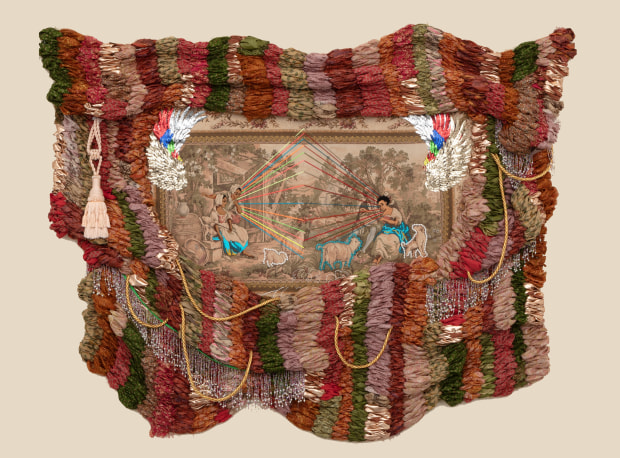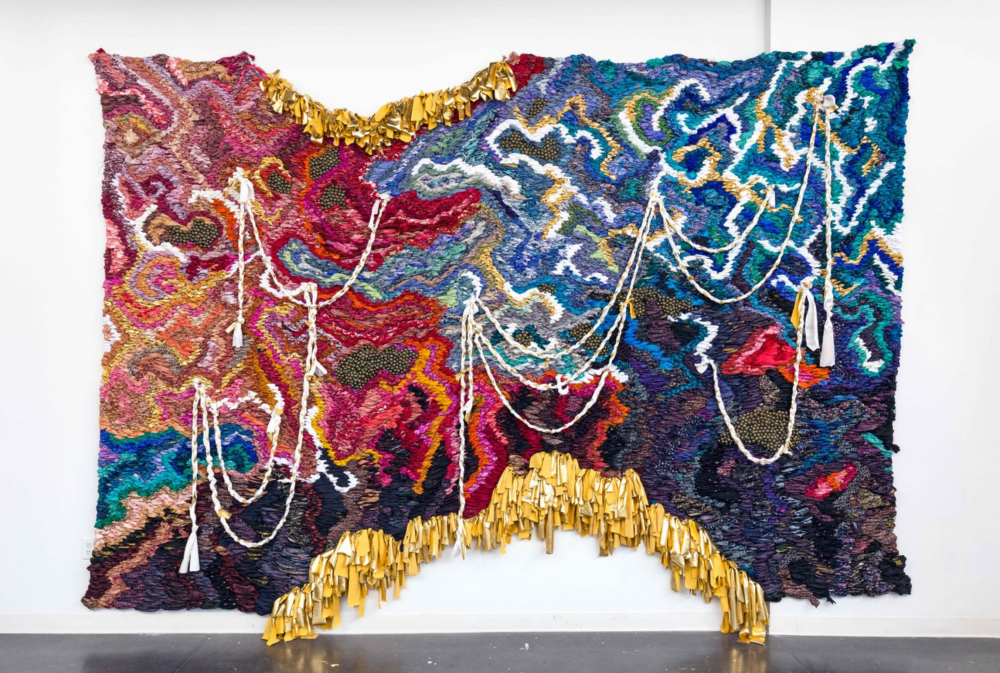

Forecast Form: Art in the Caribbean Diaspora, 1990s–Today, just opened at the Institute of Contemporary Art, simmers with the unease of an impossible task nonetheless well-executed. Complexity is its underpinning; coherence is its natural casualty. In that disheveled way, everything fits.
I’m always leery of exhibitions that use geography as a rubric. The act itself suggests a monolith, or at least some degree of sameness, which is almost never the case. In the Caribbean, 13 independent countries and more than a dozen dependent territories cluster amid 700 islands in the aquamarine seas of its broad archipelago. Each has its own particular history linked to colonial affiliations still malingering behind tourism’s sunny sheen.
As a microcosm of modernity, the Caribbean compels, with colonial malaise a key shared feature. Just one example is Hispaniola. Split between Haiti (a former French colony, where an enslaved people’s revolt led to the region’s first independent state in 1804) and the Dominican Republic (Spain), the island bottles up centuries of global colonial upheaval and fallout in a tight 30,000 square miles, roughly the size of Maine.
As a crucible for the contemporary world, the region is also fertile ground for art; by coincidence, the Portland Museum of Art opened its own show of Caribbean contemporary art this month, playing off a historical collection of photographsborrowed from the Art Gallery of Ontario.
The show takes pains to get its arms around the region’s multifarious history, opening with Suchitra Mattai’s An Ocean Cradle, 2022, a broad tapestry woven of fragments of silky Indian saris. A conceptual seascape, it nods to South Asian heritage on various islands and in Guyana, where indentured Indian labor was imported to replace enslaved people when the practice was abolished in British Caribbean colonies in the 1830s.
Popular imaginings of the Caribbean as a sun-filled, palm-fronded paradise are not to be found; Peter Doig’s haunting “Black Curtain (Towards Monkey Island), 2004, captures a sentiment of soft disdain.
Doig, 64, a Scottish painter who’s among the most successful of his generation, painted for years at a studio in Trinidad. He toys here with the notion of privilege, and significantly his own as a wealthy arriviste: An oblique evening seascape dotted along its coastline with pinpricks of light, the painting offers a view from on high, implying a luxe aerie above the scurryings below. Rough strokes of partly-opaque paint veil the scene in a milky scrim, suggesting, I think, the obvious: idyllic views are partial and myopic, a willful blindness to what lies beneath.
Forecast Form, which was organized by the Museum of Contemporary Art Chicago, comprises 28 artists and so many media, techniques, and national narratives that ICA curator Jeffrey De Blois’s principal achievement here is to smooth it over into a provocative and engaging visual experience. Even so, the show demands deep attention to myriad particular histories, an inevitably disjointing journey.
I was embarrassed to know so little about the anti-Black policies of the Dominican Republic’s longtime dictator Rafael Trujillo, who was assassinated in 1960. Their legacy lives in the austere forms of Engel Leonardo’s Jimayaco, 2017, a stand of sleek, pale ceramics buttressed by the structure of dark-toned wood from the island’s native guayacan trees. In a nearby darkened gallery, Deborah Jack’s lushly beautiful, seven-channel video illuminates the viewer with verdant glades of pomegranate trees set against archival footage of literal salt mines, tended by pickax, shovel, and bucket by Black laborers on the Dutch colonial territory of Sint Maarten. Jack, born in Rotterdam and now a part-time resident of the island, seems to imply that its extravagant surface beauty has always veiled a darkness below, just as true almost anywhere that’s endured colonial conquest.
Here, we circle back to the thesis, of the Caribbean’s microcosmic foretelling of the post-modern world. It’s a worthy notion, to be sure; many Caribbean islands served as way stations in the era of triangular trade, where commodities like rum, sugar cane, and enslaved people were exchanged en route to Europe or the Americas. European-owned plantation systems on islands like Jamaica or Barbados parallel the same brutal circumstances in the United States; the exhibition suggests that the islands were a “laboratory” for their rise in the US.
For a vivid narrative centered on a Barbadian plantation, give Esi Edugyan’s Washington Black a read, if you can stand it. A 2018 Booker Prize nominee, it’s poetic, vicious, and unflinching. Joscelyn Gardner’s five lithographs on mylar of various Caribbean flora arranged in vaguely human-portrait form offer a visual representation. Surreally crisp — that’s the effect of the mylar, translucent and fine, more visually negotiable than paper — each represents a story of a real, enslaved Black woman that Gardner discovered in her research. She merges them with the diaries of Thomas Thistlewood, who oversaw the Egypt plantation in Westmoreland, Jamaica, in the late 1700s, and who wrote, vividly, of the multiple acts of rape and torture he inflicted on enslaved women there. Gardner’s portraits are a botanical response: each species was believed to induce abortion.
This is stern stuff, and Forecast Form, appropriately, offers little in the way of relief. A musing on hybridity from Boston-raised Lorraine O’Grady, whose Brooklyn museum-led career survey opens at the Davis Museum in the new year, gives a little: The Strange Taxi: From Africa to Jamaica to Boston in 200 Years, 1991/2019, an ebullient photo composite mash-up of several generations of women in her family packed into a cab, feels light-hearted but carries all the freight of migration, forced or otherwise. Another, The Fir-Palm, 1991/2019, is more on the nose: the rough stalk of a palm tree protrudes from a Black woman’s back, topped with pine boughs of New England, O’Grady’s journey in sum.
But even a viewer striving to make connections will be left largely with discreet experiences from one work to the next. There’s some synergy; in the final gallery, Daniel Lind-Ramos’s Figura de Cangrejos, 2018-2019, a semi-human figure cobbled of cast-off junk squares off with María Magdalena Campos-Pons’s Sugar/Bittersweet, 2010, a stand of rusted spears stood upright in cakes of hard cane sugar. But it’s mostly a material resonance.
Lind-Ramos’s ramshackle creature — a coconut grater for a head; long, desiccated palm leaves as claw-like arms — lopes unsteadily along, an effigy of make-do on his home island of Puerto Rico, a neglected corner of the American empire. Campos-Pons’s sparse, prickly display is more rooted in dire colonial history: the spears are Yoruba, the African group brought to the island as slaves from which many Black Cubans — Campos-Pons’s background — are believed to descend. Discs of sugar — the cash crop enslaved people were imported to harvest — are stacked like vertebrae and shade from deep, rich brown to chalk white. Campos-Pons, a newly minted MacArthur “genius” fellow who grew up on a Cuban sugar plantation that once used enslaved labor, means it as an evocation of the skin-tone caste system that evolved there, as in many other Caribbean nations.
Thick with information and strong work, Forecast Form overwhelms. A final piece here, exclusive to the ICA, summed up what I was feeling: Teresita Fernández’s Manigua (Mirror), 2023, is a ragged nocturne of palm jungle built of expended charcoal and black sand on an almost-buried mirror backdrop. I could hardly see my way through, by design: “Manigua” means “jungle” But in Fernandez’s native Cuba, metaphorically, it also means both something akin to quagmire, impossible to resolve, and a deep refuge, densely rich despite its tangles. As a mirror of the region itself, Forecast Form achieves the same.
Image: Suchitra Mattai, An Ocean Cradle, 2022.